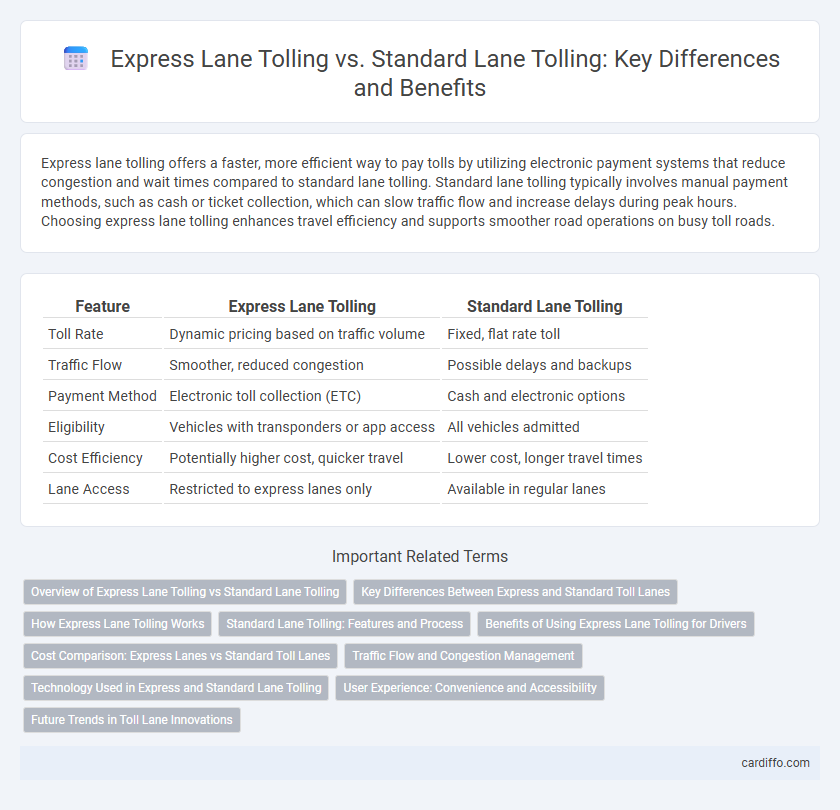Express lane tolling offers a faster, more efficient way to pay tolls by utilizing electronic payment systems that reduce congestion and wait times compared to standard lane tolling. Standard lane tolling typically involves manual payment methods, such as cash or ticket collection, which can slow traffic flow and increase delays during peak hours. Choosing express lane tolling enhances travel efficiency and supports smoother road operations on busy toll roads.
Table of Comparison
| Feature | Express Lane Tolling | Standard Lane Tolling |
|---|---|---|
| Toll Rate | Dynamic pricing based on traffic volume | Fixed, flat rate toll |
| Traffic Flow | Smoother, reduced congestion | Possible delays and backups |
| Payment Method | Electronic toll collection (ETC) | Cash and electronic options |
| Eligibility | Vehicles with transponders or app access | All vehicles admitted |
| Cost Efficiency | Potentially higher cost, quicker travel | Lower cost, longer travel times |
| Lane Access | Restricted to express lanes only | Available in regular lanes |
Overview of Express Lane Tolling vs Standard Lane Tolling
Express lane tolling uses variable pricing to manage traffic flow and reduce congestion by charging higher tolls during peak hours, while standard lane tolling applies fixed rates regardless of traffic conditions. Express lanes often incorporate electronic toll collection systems, such as E-ZPass or FasTrak, enabling faster transactions and minimizing stops compared to traditional toll booths in standard lanes. This dynamic pricing model encourages carpooling and off-peak travel, improving overall road efficiency and travel time reliability.
Key Differences Between Express and Standard Toll Lanes
Express lane tolling employs dynamic pricing based on real-time traffic conditions to manage congestion and maintain higher speeds, while standard lane tolling typically uses fixed rates regardless of traffic flow. Express lanes often require electronic toll collection systems such as transponders for seamless access, whereas standard lanes may accept both electronic payments and cash. The primary difference lies in traffic management efficiency and cost variability, with express lanes incentivizing faster travel through price adjustments and standard lanes offering consistent toll charges.
How Express Lane Tolling Works
Express lane tolling utilizes dynamic pricing based on real-time traffic conditions, allowing vehicles to pay varying toll rates to bypass congestion in standard lanes. Electronic toll collection systems, such as transponders and license plate recognition cameras, facilitate seamless payment without stopping, improving traffic flow and reducing delays. This efficient tolling method incentivizes drivers to use express lanes during peak hours, optimizing road capacity and minimizing overall travel time.
Standard Lane Tolling: Features and Process
Standard lane tolling involves traditional toll booths where drivers stop to pay tolls manually, using cash or electronic payment methods. These lanes often feature multiple payment options, including exact change, credit cards, and toll transponders like E-ZPass or SunPass for faster processing. The process requires vehicles to slow down or stop, potentially causing congestion during peak hours compared to express lane tolling systems.
Benefits of Using Express Lane Tolling for Drivers
Express lane tolling reduces congestion by allowing drivers to maintain consistent speeds and avoid frequent stops, enhancing fuel efficiency and travel times. This system employs electronic sensors and transponders, enabling seamless, cashless transactions that minimize delay at toll points. Drivers benefit from reliable, predictable commutes and lower emissions due to decreased idling and acceleration.
Cost Comparison: Express Lanes vs Standard Toll Lanes
Express lane tolling typically incurs higher fees compared to standard toll lanes due to dynamic pricing models that vary based on traffic congestion and demand. Standard toll lanes charge fixed rates regardless of traffic conditions, making them more predictable but often less efficient during peak hours. The cost differential reflects the value of reduced travel time and congestion relief offered by express lanes, appealing to drivers willing to pay premium prices for faster commutes.
Traffic Flow and Congestion Management
Express lane tolling uses dynamic pricing to regulate traffic flow by adjusting toll rates based on real-time congestion levels, which helps maintain optimal speeds and reduces traffic bottlenecks. Standard lane tolling, typically a fixed-price system, often results in slower traffic and increased queues during peak hours because all vehicles pay the same toll regardless of congestion. By managing demand effectively, express lane tolling improves overall traffic efficiency and enhances congestion management on busy roadways.
Technology Used in Express and Standard Lane Tolling
Express lane tolling utilizes advanced electronic toll collection systems such as RFID transponders and automatic license plate recognition cameras to enable seamless, high-speed vehicle passage without stopping. Standard lane tolling often incorporates a combination of manual toll booths, traditional coin or card payment methods, and some automated electronic systems that require vehicles to reduce speed or stop briefly. The integration of real-time data analytics and communication technologies in express lanes enhances traffic flow efficiency compared to the more conventional and slower standard lane toll collection methods.
User Experience: Convenience and Accessibility
Express lane tolling enhances user experience by offering faster, smoother transactions through electronic payment systems, eliminating the need to stop or slow down. Standard lane tolling often requires physical toll booths, causing delays and inconvenience for drivers. The accessibility of express lanes improves traffic flow, reduces congestion, and provides greater convenience for frequent commuters and commercial vehicles.
Future Trends in Toll Lane Innovations
Express lane tolling leverages dynamic pricing using real-time traffic data and AI algorithms to optimize flow and reduce congestion compared to static rates in standard lane tolling. Emerging technologies such as vehicle-to-infrastructure (V2I) communication and automated toll collection systems enhance accuracy and efficiency in express lanes. Future trends indicate integration with connected vehicle networks and predictive analytics to further streamline toll operations and support smart city transportation ecosystems.
Express lane tolling vs standard lane tolling Infographic

 cardiffo.com
cardiffo.com